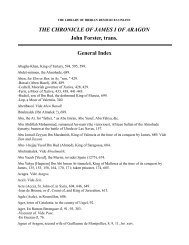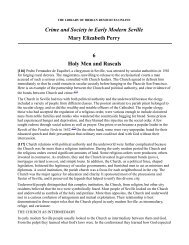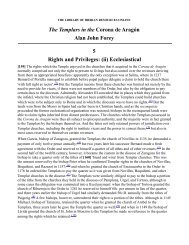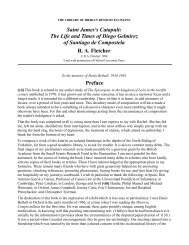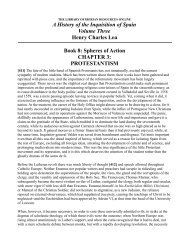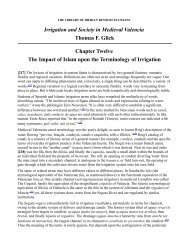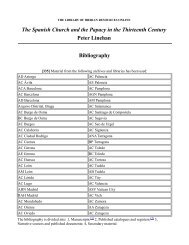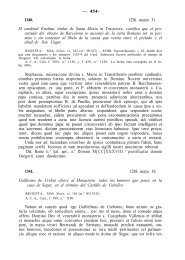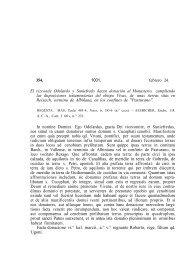Chapter 4 - The Library of Iberian Resources Online
Chapter 4 - The Library of Iberian Resources Online
Chapter 4 - The Library of Iberian Resources Online
Create successful ePaper yourself
Turn your PDF publications into a flip-book with our unique Google optimized e-Paper software.
since 'nichil in ecclesiis observabatur', and provides for the annual renewal <strong>of</strong> chrism by the parish<br />
priests. (116)<br />
<strong>The</strong> Paris statutes constantly obtrude, but there are some passages in the Summa which, as far as that<br />
source is concerned, do seem to be original. <strong>The</strong> list <strong>of</strong> penances in the section De Penitentia and the<br />
quotation from the Fourth Lateran Council via John <strong>of</strong> Abbeville ; (117) the description <strong>of</strong> the sacrament<br />
<strong>of</strong> Matrimony involving Pedro and [76] Berta; (118) certain passages on the Mass ; (119) the liturgical<br />
instructions appended to the section De vita et honestate clerico rum ; (120) and the instructions<br />
regarding ordination: (121) for these Eudes de Sully <strong>of</strong>fers no precedent. Were they, though, <strong>of</strong> Pedro de<br />
Albalat's own invention? Or did he derive them from some other contemporary source? <strong>The</strong>re were<br />
many in circulation, and the question which immediately poses itself is whether the most celebrated <strong>of</strong><br />
them all, Raymond <strong>of</strong> Peñafort's Summa de Poenitentia, is the missing link or one <strong>of</strong> the missing links.<br />
Certainly the same severely practical aim inspires both Summae, Raymond's and Pedro's. Both were<br />
compiled for the instruction <strong>of</strong> the clergy in the parish, and particularly in the parish confessional,<br />
rather than in the schools. (122) Pedro chose the same tag from St Jerome to preface his piece on<br />
Penance as did Raymond. (123) <strong>The</strong> friars are accorded special honour by Pedro and recommended as<br />
confessors. (124) And Raymond is known to have been at hand when Pedro's Summa was promulgated at<br />
Barcelona in 1241 and to have co-operated with the archbishop on the inquisitorial manual.<br />
For all this, though -- and, in truth, it does not amount to very much -- it cannot reasonably be<br />
maintained that the archbishop's Summa must have been inspired by Raymond, except in the sense that<br />
Pedro and Raymond breathed the same air and shared the same pastoral concern. Apart from the<br />
passages on penance, Raymundian literature <strong>of</strong>fers no obvious source for those few sections <strong>of</strong> the<br />
Summa which depart from Pedro's normal authority. (125) It is just possible that [77] one <strong>of</strong> the verse<br />
Summulae, based on Raymond's work and in circulation by about the middle <strong>of</strong> the century, provided<br />
some <strong>of</strong> the material for the eucharistic section. (126) But it is highly implausible when the man himself<br />
was there, and furthermore, it is both pointless to speculate and graceless to imply that the archbishop<br />
-- Master Pedro -- was incapable <strong>of</strong> stringing together a series <strong>of</strong> fairly commonplace sentences without<br />
assistance, simply because he was surrounded by such a wealth <strong>of</strong> talent. What is both certain and<br />
important is that the archbishop was a friend <strong>of</strong> the canonist <strong>of</strong> and the Order, and that he sympathised<br />
with those developments in pastoral theology which, in the case <strong>of</strong> confession, considered the merits<br />
and personality the sinner when it came to imposing a penance upon him. (127) For this approach, with<br />
its attention to possibilitas and associated concepts, was what distinguished Pedro de Albalat from the<br />
morality <strong>of</strong> the market-place enshrined in the old penitentials which Raymond <strong>of</strong> Peñafort, although<br />
fully aware <strong>of</strong> the difficulties involved, was in favour <strong>of</strong> abandoning. (128) Not that the Dominicans<br />
enjoyed a monopoly <strong>of</strong> this spirit <strong>of</strong> emancipation from the letter that killeth. (129) Still it was the<br />
Dominicans, rather than the well-scrubbed Cistercians, who were Pedro's main props -- as may be seen<br />
by passing from the hazardous thickets <strong>of</strong> amateur textual criticism into the sunlit and more productive<br />
pastures <strong>of</strong> hard fact.<br />
[78] By 1248 the province <strong>of</strong> Tarragona had five Dominican bishops, four <strong>of</strong> whom were closely<br />
associated with the convent <strong>of</strong> Santa Catalina at Barcelona, Raymond <strong>of</strong> Peñafort's base and the<br />
powerhouse <strong>of</strong> the Aragonese Church. (130) <strong>The</strong> year 1243, in which Pedro de Centelles was installed as<br />
bishop <strong>of</strong> Barcelona, saw also the death <strong>of</strong> the bishop <strong>of</strong> Vich, Bernardo Calvó, whose removal from<br />
the scene marked the end <strong>of</strong> an epoch. Though his personal sanctity was not in question, Bishop<br />
Bernardo had proved rather too other-worldly for the rough and tumble <strong>of</strong> a Catalan diocese, remaining<br />
so much <strong>of</strong> a Cistercian that he refused to make a will 'cum simus monachus', (131) and presiding with<br />
his high principles intact over the financial shipwreck <strong>of</strong> his see. In July 1242 the archbishop had gone




